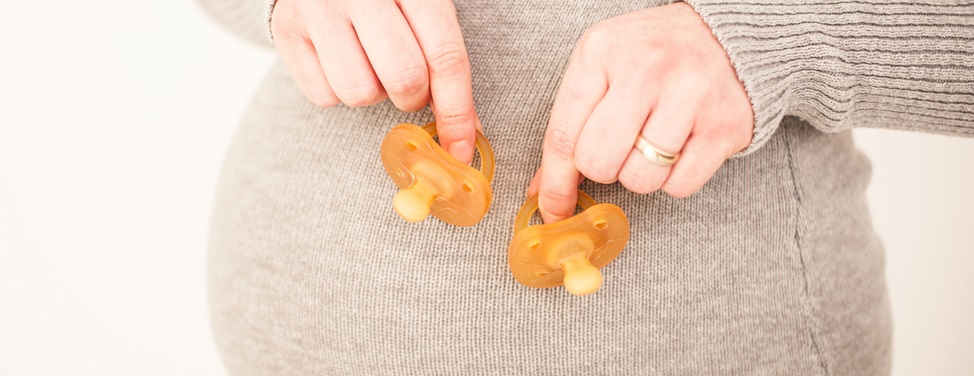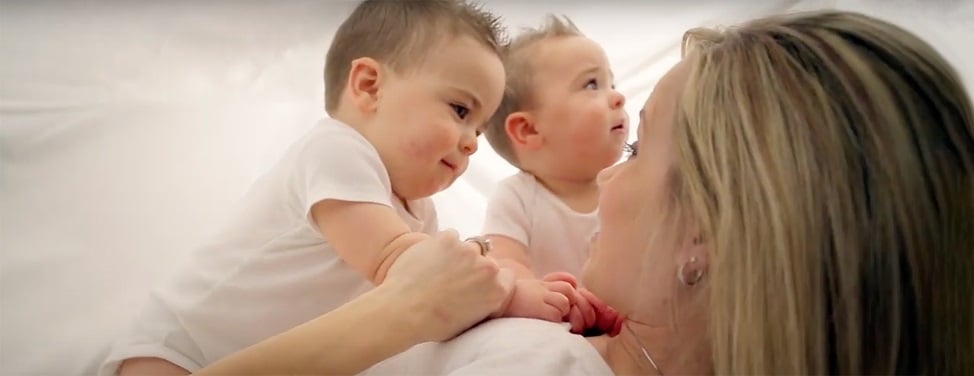Katie and Grant Riggs had only recently learned they were having twins when a routine ultrasound revealed low amniotic fluid in one of the boys' sacs — a sign of twin-to-twin transfusion syndrome. They were referred to UCSF, and after a successful fetal surgery, delivered two healthy baby boys. The Riggs answer questions about the syndrome and their treatment at UCSF Benioff Children's Hospital San Francisco.
How did you find out the boys had twin-to-twin transfusion syndrome?
Katie: Pretty soon after we found out we were having twins, an ultrasound technician discovered that one of our babies had very little fluid in his sac. They immediately referred us to UCSF, which specializes in twin-to-twin transfusion syndrome.
At UCSF we were diagnosed with stage II twin-to-twin transfusion and, in order to save their lives, we had laser ablation surgery shortly after we were diagnosed. I was 17 weeks pregnant.
Tell us about the surgery.
Grant: They had to go inside with a laser and cauterize the main blood vessels that were being shared between both babies. After the surgery, we noticed that Dylan's sac started filling with fluid within 24 hours. It was night and day from where it was the day before. It was a successful surgery and it just got better and better with each day. After a week he started having a noticeable bladder again and his recovery was well on its way.
Katie: I wasn't completely put under for the surgery, but when I kind of woke up they said, "There were four major arteries that were connecting them. We got all four of them and they're going to be fine."
Had you heard of this syndrome before?
Katie: It was a pretty quick learning curve. We knew nothing, really, about twins. We don't have twins in our family and they were completely spontaneous. So we got a really quick review on twins in general, and twin-to-twin transfusion syndrome as soon as we found out. It affects a couple thousand sets of identical twins in the United States every year. There's a foundation that's been established to support families who go through it.
How'd you get sent to UCSF Benioff San Francisco?
Katie: The ultrasound tech in San Mateo knew right away to send us to UCSF, because they're the only center in the Bay Area that deals with twin-to-twin transfusion syndrome. The day we were sent to UCSF, they knew immediately what the problem was and told us exactly what needed to be done to save their lives.
Tell us about your doctors.
Katie: Mostly we dealt with Dr. Larry Rand. He really held our hand through the entire process, told us what our prognosis was, what our options were and explained everything as we were going through it, before we had to make major decisions. It was just incredible to have people there with so much knowledge of exactly what we were going through, who deal with this all the time. We just really felt like we were in the right place.
Grant: And then we met Dr. Lee, who performed the surgery. I'd asked to meet him before the surgery because things were moving at such a fast rate, and I just wanted to look at him eye-to-eye and go over the surgery one more time. They were great about it, very accommodating. They said, "Whatever you need." They made sure we were in a good place before we went through with the surgery.
Was it time-sensitive?
Katie: It was very time-sensitive. I think our case was the earliest they've ever performed the surgery. They don't do it before 17 weeks and I was basically 17 weeks to the day. They needed to do something fairly immediately in order for Dylan to survive.
So there wasn't any time for you to shop around for medical care?
Grant: We did our research. We'd stay up late at night and try to figure out as much as we could. We'd talk with hospitals in southern California, Minneapolis and Florida, and everyone we talked to was very forthcoming and open about our odds. Everyone kind of has their own interpretation of the surgery and how it's performed, and the more research we did, we kept coming back to UCSF. We didn't really find any reason to go anywhere else and after doing the surgery, it kind of reaffirmed that this was the best choice. They had the best track record for this type of surgery, so it made sense to do it right in our backyard.
Katie: The other great thing about UCSF is, before I was going in for the surgery, they were able to get me into contact with another woman who had the surgery just days before, who was in the exact same situation as we were. She really helped me prepare for what I was about to undergo.
Tell us about the delivery.
Grant: We knew there was a high probability that they were going to be born early, and that's what happened. Katie went into labor at 30 weeks and was admitted to the hospital. She got all the way to 5 centimeters dilated, but they were able to hold it off for another four weeks and let [the twins'] lungs develop. At that time they induced her into labor, because Dylan had stopped growing and they thought that he would be better outside the womb than inside.
Katie: We really credit Dylan and Carson's lives to the experts at that hospital. They took care of us from 17 weeks [in utero], until they left the hospital, healthy and happy babies, at two weeks old.


































